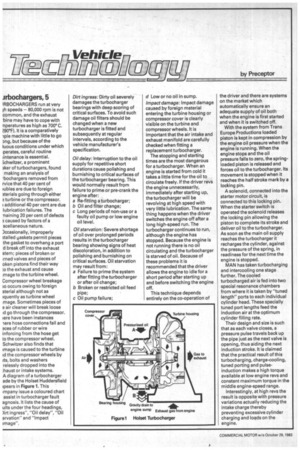arbochargers, 5
Page 38

If you've noticed an error in this article please click here to report it so we can fix it.
IRBOCHARGERS run at very )h speeds — 80,000 rpm is not common, and the exhaust tine may have to cope with nperatures as high as 700°C. ?90°F). It is a comparatively lple machine with little to go prig, but because of the
luous conditions under which perates, careful routine iintenance is essential. ichwitzer, a prominent
3ker of turbochargers, found making an analysis of tochargers removed from rvice that 40 per cent of iubles are due to foreign 3terials going through either 3 turbine or the compressor. !additional 40 per cent are due lubrication failures. The -naining 20 per cent of defects 3 caused by factors of a scellaneous nature. kcasionally, improperly 'italled gaskets permit pieces the gasket to overhang a port d break off into the exhaust stem; pieces of broken or Irned valves and pieces of oken pistons find their way :o the exhaust and cause mage to the turbine wheel. Compressor wheel breakage ;o occurs owing to foreign aterial although not as ,quently as turbine wheel mage. Sometimes pieces of
e air cleaner will break loose
d go through the compressor. iere have been instances iere hose connections fail and aces of rubber or wire inforcing from the hose get to the compressor wheel. Schwitzer also finds that image is caused to the turbine id the compressor wheels by its, bolts and washers relessly dropped into the :haust or intake systems. A diagram of a turbocharger ade by the Holset Huddersfield Ipears in Figure 1. This ,mpany issue a coloured chart assist in turbocharger fault agnosis. It lists the cause of ults under the four headings, )irt ingress", "Oil delay", "Oil arvation" and "Impact image". Dirt ingress: Dirty oil severely damages the turbocharger bearings with deep scoring of critical surfaces. To avoid such damage oil filters should be changed when a new turbocharger is fitted and subsequently at regular intervals, according to the vehicle manufacturer's specification.
Oil delay: Interruption to the oil supply for repetitive short durations cause polishing and burnishing to critical surfaces of the turbocharger bearing. This would normally result from failure to prime or pre-crank the engine after: a Re-fitting a turbocharger;
b Oil and filter change;
c Long periods of non-use or a faulty oil pump or low engine oil level.
Oil starvation: Severe shortage of oil over prolonged periods results in the turbocharger bearing showing signs of heat discoloration, in addition to polishing and burnishing on critical surfaces. Oil starvation may result from: a Failure to prime the system after fitting the turbocharger or after oil change;
b Broken or restricted oil feed Pipe; c Oil pump failure; d Low or no oil in sump.
Impact damage: Impact damage caused by foreign material entering the turbine housing or compressor cover is clearly visible on the turbine and compressor wheels. It is important that the air intake and exhaust manifold are carefully checked when fitting a replacement turbocharger. The stopping and starting times are the most dangerous for a turbocharger. When an engine is started from cold it takes a little time for the oil to circulate freely. If the driver revs the engine unnecessarily, immediately after starting up, the turbocharger will be revolving at high speed with very little lubrication. The same thing happens when the driver switches the engine off after a long high-speed run. The turbocharger continues to run, although the engine has stopped. Because the engine is not running there is no oil circulating and the turbocharger is starved of oil. Because of these problems it is recommended that the driver allows the engine to idle for a short period after starting up and before switching the engine off. This technique depends
I entirely on the co-operation of
the driver and there are systems on the market which automatically ensure an adequate supply of oil both when the engine is first started and when it is switched off. With the system from Trans Europe Productions loaded piston is kept in compression by the engine oil pressure when the engine is running. When the engine stops and the oil pressure falls to zero, the springloaded piston is released and forces oil to the turbocharger. Its movement is stopped when it reaches the half stroke mark by a locking pin. A solenoid, connected into the starter motor circuit, is connected to this locking pin. When the starter switch is operated the solenoid releases the locking pin allowing the piston to complete its stroke and deliver oil to the turbocharger. As soon as the main oil supply reaches the turbocharger it recharges the cylinder, against the pressure of the spring, in readiness for the next time the engine is stopped. MAN has taken turbocharging and intercooling one stage further. The cooled turbocharged air is fed into two special resonance chambers from where it is taken by "tuned length" ports to each individual cylinder head. These specially tuned port lengths feed the induction air at the optimum cylinder filling rate. Their design and size is such that as each valve closes, a pressure pulse travels back up the pipe just as the next valve is opening, thus aiding the next induction stroke. It is claimed that the practical result of this turbocharging, charge-cooling, tuned porting and pulseinduction makes a high torque available at low engine revs and constant maximum torque in the middle engine-speed range. Interestingly, at high revs the result is opposite with pressure variations actually reducing the intake charge thereby preventing excessive cylinder charging and loads on the engine.




























































































